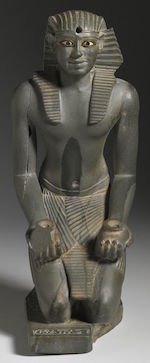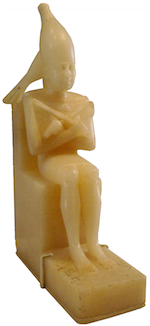
Pepi I was the son of Teti and queen Ipuet and the third Pharaoh of the Sixth Dynasty. He took the throne name Mery-Re (“beloved of Re”). It is unclear whether he had to wrest power back from the usurper Userkare, or whether his predecessor merely held the throne until Pepi was old enough. Pepi certainly defaced the cartouche of his predecessor, and it is notable that Userkare’s name (“strong is the ka of Re”) is more in keeping with the sun worship which Unas (the last king of the Fifth Dynasty) and Teti had apparently rejected. Either way, he had a long and prosperous reign (53 years according to Manetho).
Pepi built temples at Tanis, Bubastis, Abydos, Dendera, and Koptos. He maintained a garrison in Nubia to control trade links to Punt, and there is evidence of numerous war campaigns into Sinai, south Palestine, and Asia.

Pepi seems to have had a number of wives including Ankhnesmerire I (who gave birth to the future Pharaoh Merenre and the princess Neith who later married Pepi II), Ankhnesmerire II (who bore the future Pharaoh Pepi II), Nebwenet, Inenek-Inti, and Nedjeftet.
There was at least one attempt on Pepi’s life involving one of his many wives and (it is suggested) the Vizier! The conspirators were caught, but their names have not been confirmed.
There is also evidence that the power of the nobles was growing during his reign. Their tombs were lavish and provide us with detailed biographies of characters in the Royal court, such as Weni who describes an incursion into Palestine by the pharaoh’s army;

“I crossed in ships, together with these troops. I put to land at the back of the height of the mountain range to the north of the land of the Sand-Dwellers, while (the other) half of this army were travelling by land. I turned back, I obstructed all of them and slew every rebel among them.”
A copper statue of Pepi found in the temple of Hierakonpolis (Nekhen) is the earliest known example of a life size metal sculpture. A number of smaller pieces were also discovered in the temple, including a copper statue of the king with his son Merenre I and a small alabaster statue of the seated king.
Pharaoh’s Names
Manetho; Phios
Horus Name
Hr mry tAwy (Horus Merytawy) – Horus Who Loves The Two Lands
Nebti Name
nbti mri ht (Merykhet Nebti) – The Two Ladies, Beloved Of Body)
Golden Horus Name
bikw nbw(w) (Biku-Nebu) – The Golden Falcons
Prenomen
nfr sA Hr (Nefersahor) – Horus Is Perfect In Protection (Abydos kings list)
Prenomen
mry ra (Merire) – Beloved Of Re (Saqqara kings list)
Nomen
ppy (Pepi)
sA ra ppy (Sa Re Pepi) – Pepi Son Of Re
sA HwtHr nbti iwnt ppy (Son Of Hathor The Lady Of Dendara, Pepi)
sA (i)tm nb iwnw HwtHr nbt iwnt ppy (Son Of Atum, The Lord Of Dendara And Hathor, The Lady Of Dendara, Pepi)
Bibliography
- Dodson, A and Hilton, D. (2004) The Complete Royal Families of Ancient Egypt
- Hornung, Eric (1999) History of Ancient Egypt
- Malek, Jaromir (2000) “The Old Kingdom”, in The Oxford History of Ancient Egypt Ed I. Shaw
- Van de Mieroop, Marc (2010) A History of Ancient Egypt
- Wilkinson, Toby (2010) The Rise and Fall of Ancient Egypt
Copyright J Hill 2008